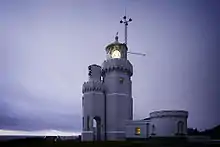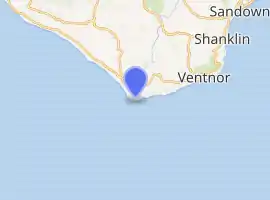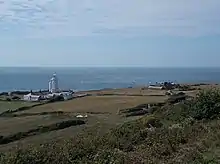St Catherine's Lighthouse
St Catherine's Lighthouse is a lighthouse located at St Catherine's Point at the southern tip of the Isle of Wight. It is one of the oldest lighthouse locations in Great Britain.
 The lighthouse, with fog-signal tower attached | |
 Isle of Wight | |

| |
| Location | St Catherine's Point Isle of Wight England |
|---|---|
| Coordinates | 50°34′32.4″N 1°17′51.9″W |
| Year first constructed | c. 1323 (first) |
| Year first lit | 1838 (current) |
| Automated | 1997 |
| Construction | ashlar |
| Tower shape | hexagonal tower |
| Markings / pattern | white tower and lantern |
| Tower height | 27 m (89 ft) |
| Focal height | 41 m (135 ft) |
| Current lens | 2nd order four panel catadioptric |
| Intensity | 821,000 candela |
| Range | 25 nmi (46 km; 29 mi) |
| Characteristic | Fl W 5s. |
| Admiralty number | A0774 |
| NGA number | 1064 |
| ARLHS number | ENG-143 |
| Managing agent | Trinity House[1] |
| Heritage | Grade II listed building |
Origins
The first lighthouse was established on St Catherine's Down in 1323 on the orders of the Pope, after a ship ran aground nearby and its cargo was either lost or plundered. Once part of St Catherine's Oratory, its octagonal stone tower can still be seen today on the hill to the west of Niton. It is known locally as the "Pepperpot".[2] Nearby there are the footings of a replacement lighthouse begun in 1785, but this was never completed because the hill is prone to dense fog.[3] It is sometimes called the "salt pot".[4]
History

The new lighthouse, built by Trinity House in 1838, was constructed as a 40-metre (130 ft) stone tower. When first built the light was oil-fuelled; its lamp, with four concentric wicks, was set within a large (first-order) fixed dioptric lens, built by Cookson & co. and surmounted by 250 mirrors (which were later replaced with prisms).[5] It was first lit on 1 March 1840;[6] however, the light was often obscured by fog, which led in due course to the height of the tower being reduced by 13-metre (43 ft) in 1875. At the same time the lamp was increased from four wicks to six and a system of 'dioptric mirrors' (prisms) was installed to redirect light from the landward side of the lamp out to sea.[7]
In 1868 a Daboll trumpet fog signal was installed in a building on the cliff edge;[8] it used an Ericsson 4 hp caloric engine to sound a reed attached to an acoustic horn, once every 20 seconds.[9] In October 1876, the reed was changed to a more powerful siren which sounded two blasts every four minutes.[9]
In the 1880s the decision was taken to convert the St Catherine's light to electric power. In 1888 a carbon arc lamp was installed, linked to a powerful set of De Méritens magneto-electric machines, powered by three Robey non-condensing compound steam engines. (St Catherine's was the last English lighthouse to be provided with an arc lamp).[10] A new optic was also provided (a second-order 16-sided revolving dioptric lens array by Chance & co.)[11] which showed a five-second flash every thirty seconds. As well as a new Engine House, more cottages were built, to accommodate the additional staff required to operate the generating plant.[12]
A new fog signal house was also built in 1888; in it a pair of double-noted 5-inch sirens were installed, sounding through a pair of upright horns, which emerged through the roof and were angled out to sea.[13] Compressed air for the sirens was piped underground from the engine house, where the three engines were linked to an air compressor by way of a common drive shaft;[14] compressed air was also used to power the mechanism that turned the lens. The sirens sounded two blasts every minute: a higher note followed by a low note.[12]
From 1890 a narrow red sector was added to the light, to warn vessels from approaching too near to the shore west of St Catherine's Point.[15] In addition to the flashing light showing red in this direction, a subsidiary apparatus redirected a fixed beam of light upwards from the rear of the main lens and reflected it to shine red in the same direction.[7]
In 1901 a series of trials of different sirens and reeds attached to trumpets of different sizes and designs took place at St Catherine's (which had sufficient engine power to produce the required volume of compressed air). The tests were overseen by Lord Rayleigh, scientific adviser to Trinity House, whose distinctive and eponymous design of fog signal trumpet was installed at several different fog signal stations (though not at St Catherine's itself) in the wake of the trials.[14]
In 1904 the 16-sided optic was removed from St Catherine's (and installed instead in South Foreland Lighthouse). A new, more powerful 4-sided optic, manufactured by Chance Brothers, was installed in its place.[16] The new apparatus, borne on a trough of mercury and driven by a large clockwork mechanism,[17] revolved much faster to give a much quicker flash, once every five seconds.[18] It was said at the time to be 'the most powerful flash-light in [the] country', at 15,000,000 candlepower (compared to the 3,000,000 candlepower formerly produced by the old lens).[17] The beam (albeit reflected on the clouds) could often be seen from Barfleur, 60 miles away.[19] As part of the 1904 upgrade, the red sector light was reconfigured to shine from a window lower down in the tower, 20 ft (6.1 m) below the lantern; it continued to use light redirected from the landward side of the main lamp, by way of a series of lenses and prisms.[20]

The arc lamp was decommissioned in the 1920s; by this time it was the last operational arc lamp in a lighthouse in the UK (it is now displayed as an exhibit in Southsea Castle.)[21] It was replaced by a 4 kW filament lamp powered by mains electricity; an automatic lamp changer was provided, to engage a standby electric lamp in the event of a bulb failure (and a standby acetylene lamp in the event of a power failure). The 1904 optic was retained, with the addition of an electric winder to the clockwork rotation drive.[22]
By 1932 the fog horn house was being undermined by erosion; it was demolished and a second (smaller) tower was then built alongside the lighthouse to house a new more powerful 12-inch siren. On 1 June 1943 a bombing raid destroyed the engine house, killing the three duty keepers.[23] As part of the post-war repairs, a diaphone was installed in place of the siren. This was itself replaced by a 'supertyfon' air horn in 1962, when new engines and compressors were also installed; the fog signal was discontinued in 1987.[14]
Present day
.jpg.webp)
Today, the lighthouse has a range of 25 nautical miles (46 km; 29 mi) and is the third-most powerful of all the lights maintained by Trinity House.[24] The 1904 revolving optic is still in use (as of 2020). The red sector light, shown from a window lower in the tower, marks Atherfield Ledge.[24] In 2020, Trinity House made a planning application to remove the 2nd order Fresnel lens and replace it with an LED system.[25]
A team of volunteers used to provide tours of the lighthouse year round; however in January 2020 Trinity House announced that St Catherine's lighthouse would have to 'close its doors to the visiting public as a tourist attraction' claiming that it was no longer economically viable to keep the visitor centre open.[26] Cottages around the lighthouse can be rented out as holiday accommodation.
References
- St Catherine's Archived 15 March 2018 at the Wayback Machine The Lighthouse Directory. University of North Carolina at Chapel Hill. Retrieved 26 April 2016
- Woodman and Wilson (2002). The Lighthouses of Trinity House. Bradford on Avon: Reed. ISBN 1-904050-00-X.
- "History of the lighthouse at St Catherine's Point". National Trust. Archived from the original on 10 December 2017. Retrieved 1 May 2019.
- "A colourful history behind St Catherine's Oratory". National Trust. Archived from the original on 1 May 2019. Retrieved 1 May 2019.
- Davenport Adams, W. H. (1891). The Story of our Lighthouses and Lightships: Descriptive and Historical (PDF). London, Edinburgh & New York: Thomas Nelson & Sons. p. 122. Archived (PDF) from the original on 3 May 2017. Retrieved 27 February 2019.
- "Lighthouse management : the report of the Royal Commissioners on Lights, Buoys, and Beacons, 1861, examined and refuted Vol. 2". p. 81. Archived from the original on 4 April 2016. Retrieved 3 March 2019.
- "1892 Institution of Mechanical Engineers: Visits to Works (13: St Catherine's Lighthouse)". Grace's Guide. Archived from the original on 6 March 2019. Retrieved 3 March 2019.
- Elliot, George H. (1875). European Light-House Systems. London: Lockwood & co. p. 133. Retrieved 10 March 2019.
- "Fog Signals". Parliamentary Papers, volume LXIV. 23 (337): 2–4. 1 August 1879.
- Schiffer, Michael Bryan (2008). Power Struggles: Scientific Authority and the Creation of Practical Electricity before Edison. Cambridge, Massachusetts: MIT Press. p. 278.
- Chance, James Frederick (2018). A History of the Firm of Chance Brothers & Co. Sheffield: Society of Glass Manufacturers. p. 178.
- Woodman, Richard; Wilson, Jane (2002). The Lighthouses of Trinity House. Bradford-on-Avon, Wilts.: Thomas Reed. pp. 96–97.
- postcard image
- Renton, Alan (2001). Lost Sounds: The Story of Coast Fog Signals. Caithness, Scotland: Whittles.
- London Gazette, Issue 26038, Page 1975, 1 April 1890
- s:1911 Encyclopædia Britannica/Lighthouse
- "St Catherine's Electric Lighthouse". The Electrical Review. 55 (1414): 1076. 30 December 1904.
- London Gazette, Issue 27720, Page 6452, 7 October 1904
- "Lighthouses and the Optical Apparatus used in them". Proceedings of the Optical Convention (1): 377. 1926.
- Talbot, Frederick A. (1913). Lightships and Lighthouses. London: William Heinemann.
- "Southsea Castle Lighthouse". Waymarking.com. Archived from the original on 1 April 2019. Retrieved 16 March 2019.
- Cooper, F. W. (1979). Twenty Years in Lighthouses (PDF). United States Lighthouse Society. pp. 10–14. Retrieved 13 March 2019.
- "St Catherine's Lighthouse". Red Funnel. Archived from the original on 26 March 2019. Retrieved 26 March 2019.
- "St Catherine's Lighthouse". Trinity House. Archived from the original on 6 March 2019. Retrieved 3 March 2019.
- Hill, Louise (21 August 2020). "St Catherine's Lighthouse goes green with LED lights". County Press. Retrieved 24 August 2020.
- "St Catherine's Lighthouse closes its doors to visitors and unlikely to reopen". On The Wight. Retrieved 1 April 2020.
External links
- St Catherine's Lighthouse in Lighthouse Digest's Lighthouse Explorer Database
- Trinity House
- Photos and information on St Catherine's Lighthouse
| Wikimedia Commons has media related to St. Catherine's Lighthouse. |